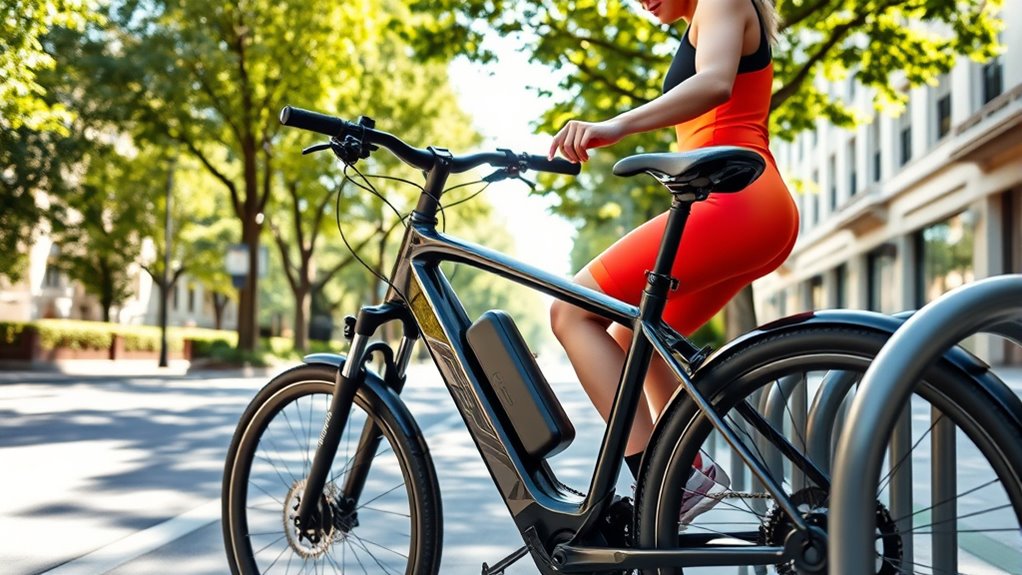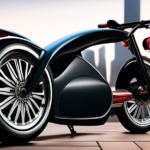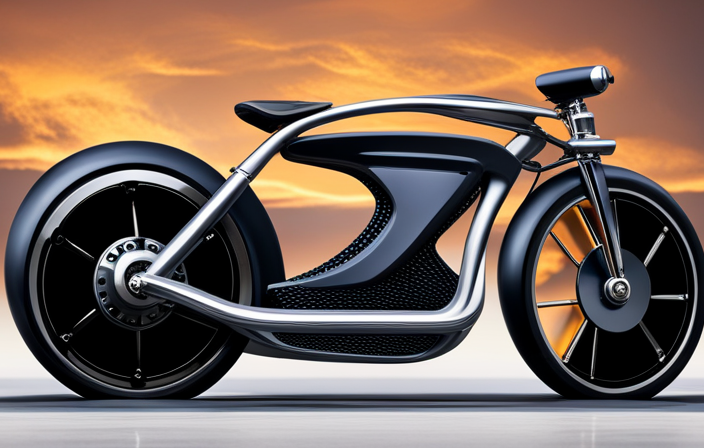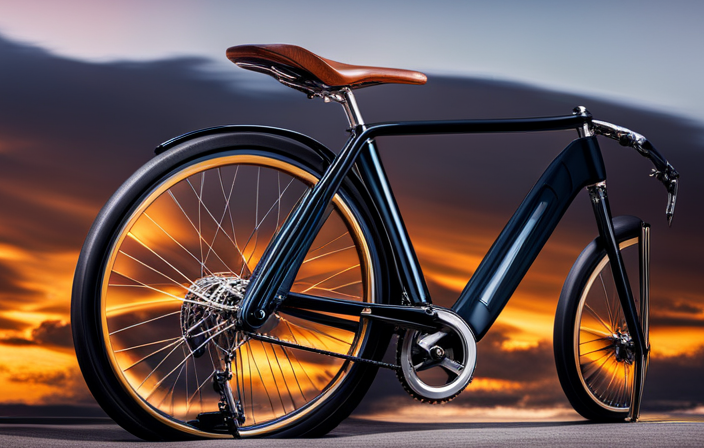To maximize your e-bike battery life, follow proper charging techniques such as avoiding full 100% charges and unplugging when at around 85-90%. Adopt good habits like keeping the charge between 30% and 80%, recharging before it drops below 20%, and avoiding deep discharges. Store your battery in a cool, dry place and maintain it regularly. Smart riding, timely maintenance, and understanding your battery’s needs will help you get the most from your e-bike—explore more tips to keep it in top shape.
Key Takeaways
- Keep charge levels between 30-80%, avoiding full charges or deep discharges to prevent capacity loss.
- Use manufacturer-approved chargers and avoid overcharging by unplugging once at 85-90%.
- Store the battery in a cool, dry environment at 15-20°C and remove it during long-term storage.
- Perform regular full charge cycles monthly for cell balancing and monitor battery health via management systems.
- Minimize high-power assist and rapid acceleration to reduce heat and prolong battery lifespan.
Master Proper Charging Techniques

To maximize your e-bike battery life, mastering proper charging techniques is essential. You should aim to charge your battery to around 80-90%, avoiding a full charge whenever possible, as consistently reaching 100% accelerates capacity loss. Monitor the charge level regularly to prevent overcharging, and unplug the battery once it hits the ideal level. Using a slower charger, such as 2A, helps reduce heat buildup and minimizes battery degradation during charging. Refrain from leaving your battery plugged in after it’s fully charged, as overcharging can harm its capacity. Additionally, perform full charge cycles from about 20% to 100% once a month to maintain cell balancing. Proper battery management and cautious storing your battery when not in use will ensure maximum longevity and performance. Being aware of your battery’s state of health can help you identify early signs of capacity decline and plan replacements accordingly. Regularly checking your battery’s chemical composition can provide insights into its overall condition and longevity. Incorporating advanced battery management systems can further optimize charging and extend overall battery lifespan. Understanding the effects of temperature fluctuations on battery performance can help you adopt better storage and usage habits, as extreme temperatures can significantly impact battery capacity and safety.
Adopt Effective Charging Habits

To extend your e-bike battery’s lifespan, you should charge before it drops below 10% and avoid fully depleting it. Using slower chargers helps prevent excess heat and keeps the battery healthy. Remember to disconnect once it reaches around 85-90% to prevent overcharging and thermal stress. Additionally, maintaining proper battery cooling during charging can significantly improve overall longevity. Proper battery maintenance and avoiding high-temperature environments can also help preserve battery health over time. Regularly monitoring your battery health can also help identify potential issues early and ensure optimal performance. For optimal results, avoid exposing the battery to extreme temperature fluctuations that can accelerate degradation. Understanding contrast ratio and its impact on image quality can also help you optimize your device usage and prevent unnecessary strain on the battery.
Charge Before Low Levels
Charging your e-bike battery before it drops below 20% helps prevent capacity loss and reduces stress on the cells. Keeping the battery within a healthy charge range can extend its lifespan and maintain peak performance. To do this:
- Avoid deep discharges by recharging before the battery reaches zero.
- Aim to keep the charge level between 30% and 80%, preventing full discharges or overcharging.
- Use your battery’s management system or app to monitor and maintain proper charge levels during rides and storage.
- Incorporating data privacy considerations when using your e-bike’s connected features can help protect your personal information and ensure safe operation.
Use Proper Chargers
Using the correct charger is essential for maintaining your e-bike battery’s health. Always use the manufacturer-approved charger that matches your battery’s voltage and amperage specifications. This ensures you charge to a full capacity safely without risking damage. Using inappropriate chargers can lead to overcharging, which causes heat buildup and accelerates battery wear. To optimize lifespan, disconnect the charger once your battery reaches 80-90%. Additionally, selecting the proper charger type can further help in preventing damage and prolonging battery life. Ensuring your charger has the appropriate electrical compatibility reduces the risk of malfunction and enhances the overall safety of your charging process. Incorporating proper charging habits can also prevent unnecessary strain on your battery and extend its overall lifespan.
Avoid Full Discharges
Avoid letting your e-bike battery fully discharge whenever possible, as deep discharges can cause irreversible damage and shorten its lifespan. When your battery hits 0%, it risks capacity degradation, reducing overall battery capacity and effectiveness. To protect your battery health, aim to keep the charge level between 20% and 80%, avoiding full discharges that accelerate capacity loss. Regularly recharging before reaching 10% helps maintain ideal capacity and prolongs battery life. Using proper charging habits can significantly extend your battery’s lifespan and performance. Additionally, understanding the importance of fathers’ influence can inspire responsible maintenance and care of your e-bike, similar to how a father nurtures growth and resilience. Incorporating battery maintenance practices, such as avoiding extreme temperatures, also plays a crucial role in preserving battery health over time. Maintaining consistent charging routines is essential for optimal battery longevity and performance. Furthermore, being mindful of battery calibration can help ensure accurate charge level readings and better overall management.
Select the Ideal Battery Capacity

How do you determine the right battery capacity for your electric bike? Start by considering your typical riding distance and how far you want to go on a full charge. A larger battery, like 17Ah, can provide up to 100 km, while an 11Ah battery may cover around 30 km. Think about your terrain and riding style—hilly or long-distance rides benefit from higher capacity batteries to ensure sufficient power reserves and reduce the need for frequent recharging. Keep in mind that bigger batteries are heavier and more expensive but offer longer range and fewer recharge cycles. To maximize efficiency, select a battery size that balances your daily cycling distance with portability and budget, preventing unnecessary weight and cost while meeting your riding needs. Additionally, understanding battery specifications can be beneficial for choosing the most suitable power source for your riding habits.
Prevent Deep Discharges and Overcharging
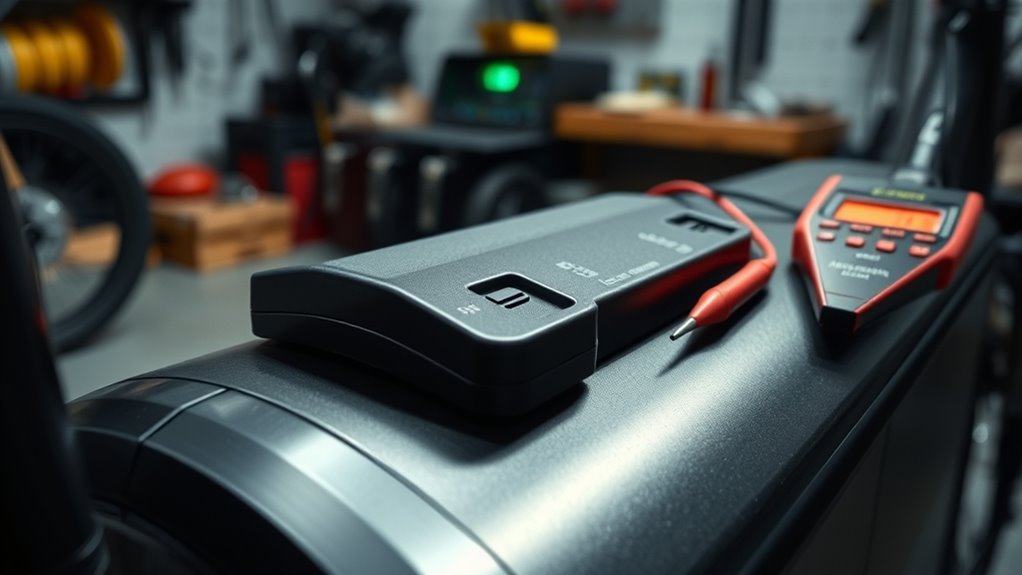
To extend your e-bike battery’s lifespan, you should keep its charge between 20% and 80%. Avoid letting it drop below 10% or stay at 100% for too long, as both can cause damage. Using the right charger and unplugging once fully charged helps prevent unnecessary overcharging.
Maintain Proper Charge Levels
Maintaining proper charge levels is essential for extending your e-bike battery’s lifespan. Keeping your battery between 20% and 80% charge helps reduce capacity fade caused by frequent full charges and deep discharges. Avoid discharging the battery below 10%, as deep discharges accelerate deterioration. When storing your e-bike, don’t leave the battery fully charged at 100%, since it can weaken the cells over time. Instead, recharge promptly after rides to keep the charge level within ideal limits. To preserve battery health, follow manufacturer recommendations and avoid overcharging by unplugging once it’s fully charged. Think of your battery’s health as a balance:
- Limit charge level fluctuations
- Prevent deep discharges
- Avoid prolonged storage at full capacity
Use Appropriate Charging Cycles
Using the right charging cycles helps prevent unnecessary wear on your e-bike battery. To preserve battery capacity and cell health, avoid deep discharges below 10% and limit full charge cycles to when necessary. Instead, opt for partial charging around 80% for daily use, which reduces stress on the cells and extends battery life. Fully charging the battery only occasionally helps maintain excellent cell health without accelerating degradation. For long-term storage, keep the battery between 30% and 60%, avoiding prolonged periods at 100%. This approach minimizes capacity loss and maintains overall battery health over time. By managing your charge cycles carefully, you ensure your e-bike’s battery stays healthy, reliable, and capable for longer rides.
Use Battery Management Strategies
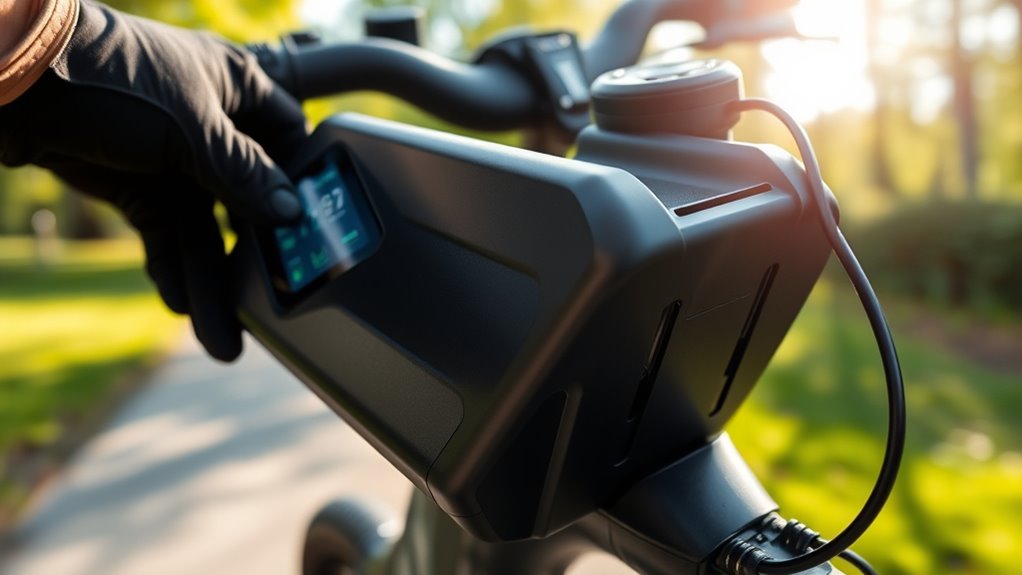
Implementing effective battery management strategies can substantially extend your e-bike’s battery life. To do this, monitor and adjust your charging habits, keeping the battery between 30% and 80% capacity to reduce stress on the cells. Use your bike’s built-in battery management system (BMS) features, like cell balancing, to ensure uniform charge distribution and prevent premature capacity loss. Avoid deep discharges below 10%, as they accelerate capacity degradation and shorten lifespan. Additionally, opt for chargers with appropriate amperage (2A or 4A) to minimize heat buildup and wear. Focus on partial charging cycles—topping up to 80%—to optimize charge cycles and maintain consistent performance over time, preserving full capacity longer.
Follow Safe Charging Procedures

To guarantee your e-bike’s battery stays safe and performs well, it’s essential to follow proper charging procedures. Always turn off your e-bike before unplugging or connecting the charger to prevent electrical surges. Use only manufacturer-approved chargers and cables to ensure safety and proper charging. Avoid leaving the battery charging overnight or for extended periods to reduce overheating risks. Once the battery reaches full capacity, disconnect the charger to prevent overcharging and potential damage. Regularly inspect your charging equipment for wear or damage and replace faulty chargers immediately. Properly following these steps protects your battery’s lifespan and safety.
| Step | Action | Result |
|---|---|---|
| 1 | Inspect charger regularly | Prevents safety hazards |
| 2 | Disconnect at full capacity | Avoids overcharging damage |
| 3 | Use approved equipment | Ensures safe, reliable charging |
Improve Your Riding Style for Efficiency

Proper charging keeps your e-bike’s battery in good shape, but how you ride also impacts its lifespan. To improve ride efficiency, focus on your riding style. Use pedal power actively on flat and downhill sections to rely less on motor assist, conserving battery. Select assist levels carefully, usually opting for middle settings to balance power and battery drain. Anticipate stops and coast whenever possible to avoid unnecessary acceleration and energy use. Maintain a steady pedaling cadence of 70-75 RPM to optimize motor efficiency. Avoid rapid acceleration and high assist modes, as these quickly deplete your battery. By adopting smoother, more controlled inputs, you’ll extend your ride range and maximize battery life. Small adjustments in riding habits can make a significant difference in your e-bike’s overall performance.
Store Your Battery Correctly

Storing your e-bike battery correctly is essential for maintaining its lifespan and performance. Proper battery storage involves keeping it indoors in a cool, dry environment at room temperature, ideally between 15-20°C, to prevent damage from extreme heat or cold. During long-term storage, you should remove the battery from the bike and disconnect it to reduce wear and theft risk. Maintain the charge level between 40-80%, preferably around 60%, and recharge to about 50-75% every six months if not in use. Avoid storing the battery at full 100% charge or completely discharged, as these conditions can cause capacity loss over time. By following these steps, you’ll help prevent capacity loss and prolong your battery’s overall health.
Keep up With Regular Maintenance and Updates

Regular maintenance and updates are vital for keeping your e-bike battery functioning at its best. Proper battery maintenance involves simple steps like inspecting and cleaning terminals with a dry cloth to prevent oxidation and ensure a solid connection. Staying current with firmware updates and battery management system (BMS) software guarantees your bike benefits from the latest performance improvements. Scheduling professional check-ups helps identify potential issues early and maintains prime battery health. Additionally, following recommended charging routines and promptly replacing worn or damaged connectors or cables prevent electrical faults that can shorten your battery’s lifespan. Regular hardware inspections and software updates are essential for maximizing efficiency. By staying proactive with these routines, you’ll extend your battery’s longevity and enjoy longer, more reliable rides.
Frequently Asked Questions
How Can I Make My Ebike Battery Last Longer?
To make your e-bike battery last longer, keep it charged between 40-80%, avoiding full discharges or overcharges. Store it indoors at room temperature and in a partly charged state if you’re not riding for a while. Use a slow charger, perform partial charges regularly, and disconnect the battery when not in use. Keep it away from extreme temperatures and water to prevent damage and preserve its capacity.
Should You Charge Your Ebike Battery After Every Use?
Yes, you should charge your e-bike battery after every ride. Charging consistently keeps the battery within the ideal 20-80% range, reducing stress and preventing deep discharges that can damage the cells. It also helps avoid dropping below 10%, which can harm the battery’s longevity. By topping up regularly, you maintain a healthy cycle, ensuring your e-bike stays ready and the battery lasts longer over time.
How to Save Battery on Electric Bike?
To save battery on your electric bike, you should use pedal-assist modes and keep your speed steady at 70-75 RPM. Plan routes that avoid steep hills and stops, and limit high assist levels and throttle use. Keep your battery charged between 20% and 80%, and regularly maintain your bike to guarantee efficiency. This way, you’ll extend your battery life and enjoy longer rides.
How Do I Extend the Battery Range on My Ebike?
Ever wondered how you can go farther on your e-bike? To extend your battery range, keep a steady pedaling cadence of 70-75 RPM and use lower assistance levels. Plan efficient routes to avoid steep climbs and traffic. Maintain your battery charge between 20-80%, keep tires properly inflated, and ride smoothly with eco-friendly techniques like coasting. These habits help conserve energy and maximize your e-bike’s distance per charge.
How Long Should an E-Bike Battery Last?
Your e-bike battery typically lasts 3 to 5 years or around 300 to 1,000 charge cycles. To get the most out of it, you should care for and maintain it properly. Keep it in a cool, dry place and follow smart charging habits. Using a high-quality battery and monitoring its condition can help you extend its lifespan, sometimes up to 10 years with minimal capacity loss.
Conclusion
So, there you have it—your foolproof guide to squeezing every last ounce of juice from your e-bike’s battery. Follow these tips, and you’ll be gliding further and faster, all while pretending you’re a tech-savvy battery wizard. Just remember, no amount of tricks will turn your battery into an immortal power source—so don’t forget to enjoy the ride, even if your battery decides to throw a tantrum. Happy pedaling and may your battery always be forever full!
